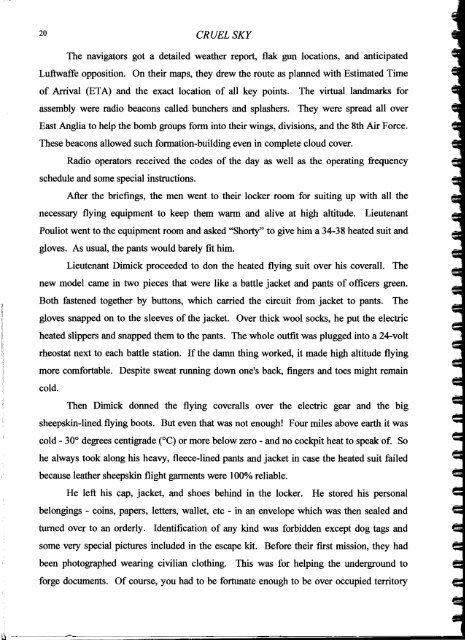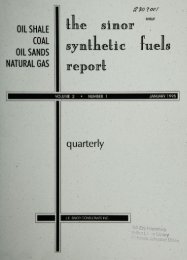Create successful ePaper yourself
Turn your PDF publications into a flip-book with our unique Google optimized e-Paper software.
20 C<strong>RUEL</strong> <strong>SK</strong>Y<br />
The navigators got a detailed weather report, flak gun locations, and anticipated<br />
Luftwaffe opposition. On their maps, they drew the route as planned with Estimated Time<br />
of Arrival (ETA) and the exact location of all key points. The virtual landmarks for<br />
assembly were radio beacons called bunchers and splashers. They were spread all over<br />
East Anglia to help the bomb groups form into their wings, divisions, and the 8th Air Force.<br />
These beacons allowed such formation-building even in complete cloud cover.<br />
Radio operators received the codes of the day as well as the operating frequency<br />
schedule and some special instructions.<br />
After the briefings, the men went to their locker room for suiting up with all the<br />
necessary flying equipment to keep them warm and alive at high altitude. Lieutenant<br />
Pouliot went to the equipment room and asked "Shorty" to give him a 34-38 heated suit and<br />
gloves. As usual, the pants would barely fit him.<br />
Lieutenant Dimick proceeded to don the heated flying suit over his coverall. The<br />
new model came in two pieces that were like a battle jacket and pants of officers green.<br />
Both fastened together by buttons, which carried the circuit from jacket to pants. The<br />
gloves snapped on to the sleeves of the jacket. Over thick wool socks, he put the electric<br />
heated slippers and snapped them to the pants. The whole outfit was plugged into a 24-volt<br />
rheostat next to each battle station. Ifthe damn thing worked, it made high altitude flying<br />
more comfortable. Despite sweat running down one's back, fingers and toes might remain<br />
cold.<br />
Then Dimick donned the flying coveralls over the electric gear and the big<br />
sheepskin-lined flying boots. But even that was not enough! Four miles above earth it was<br />
cold - 30° degrees centigrade eC) or more below zero - and no cockpit heat to speak of. So<br />
he always took along his heavy, fleece-lined pants and jacket in case the heated suit failed<br />
because leather sheepskin flight garments were 100% reliable.<br />
He left his cap, jacket, and shoes behind in the locker. He stored his personal<br />
belongings - coins, papers, letters, wallet, etc - in an envelope which was then sealed and<br />
turned over to an orderly. Identification of any kind was forbidden except dog tags and<br />
some very special pictures included in the escape kit. Before their first mission, they had<br />
been photographed wearing civilian clothing. This was for helping the underground to<br />
forge documents. Of course, you had to be fortunate enough to be over occupied territory















![pace SrntfletIc fne]its report - Alliance Digital Repository](https://img.yumpu.com/10493335/1/190x245/pace-srntfletic-fneits-report-alliance-digital-repository.jpg?quality=85)
